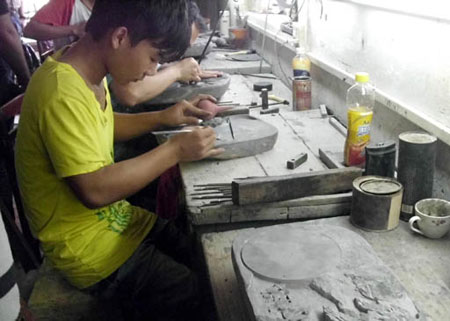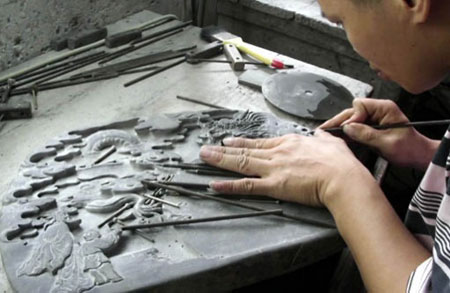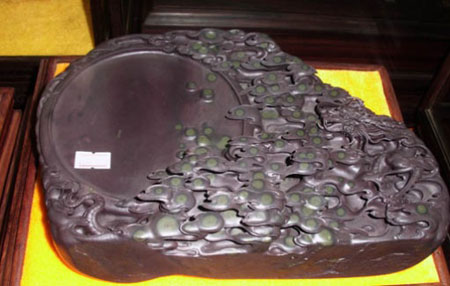Appreciating the Beauty of Inkstone
The city of Zhaoqing in Guangdong province, China, is famous for its beautiful scenery, but few people know that the city is also a producer of the most beautiful and best quality inkstone in China.
Inkstone is used as the ink plate for calligraphy. Inkstones are often transformed into true works of art, reflecting the ancient Chinese culture.
“Few people apart from artists or intellectuals can appreciate inkstone and its beauty. Now many people collect inkstone as a high social status symbol,” Wang Jian Hua, Secretary-General of the Association of Zhaoqing Inkstone, told reporters.
 Zhaoqing is known for its high quality inkstone
Zhaoqing is known for its high quality inkstoneZhaoqing was a primitive inkstone village 1,000 years ago, its inhabitants’ main occupation was crafting ink plates, and dynastic kings and queens had ordered them therefrom for centuries.
Today, households in some villages in Zhaoqing continue to practice this craft, as they can find the material easily in the area.
Compared to other areas in China, Wang acknowledged that the price for inkstone from Zhaoqing is quite high because of the quality of the stone and the craftsmanship. For one piece of inkstone of a standard size and quality, the price is around 100,000 RMB or US $ 16,000.
However, Wang said that people can also purchase an inkstone for 200 to 400 RMB. Of course, the quality is not as good.
The high price of inkstone also demonstrates respect for the craftsmen who use their rare skills to carve the stone. In Zhaoqing, the best craftsmen are paid around 3,000 RMB a day to carve the best quality inkstone.
It requires 10 steps to create an inkstone, including selecting the proper stone, carving the stone, polishing the stone, and coating the stone.
A craftsman needs at least 15 days to make a good inkstone, but the best inkstones require around 6 months of work.
“If you want to be an inkstone craftsman, you should learn from a master,” Wang said, adding that a true inkstone master always has a thousand patterns he can decorate the stone with.
Liang Peiyang is one of the Zhaoqing inkstone masters. The 43-year-old has an inkstone factory with dozens of craftsmen. Liang started his career as a craftsman when he was young, and so far he has produced several masterpieces that have made him one of the most popular inkstone craftsmen in China.
 A man carves inkstone in Zhaoqing, China
A man carves inkstone in Zhaoqing, ChinaOne of Liang’s masterpieces is an inkstone that has a dragon holding a ball on its tongue. The piece has many yellow dots like eyes.
Liang recalled that he spent 11 months carving the dragon inkstone and had little time to sleep.
“I was very excited when I knew the material had yellow dots like eyes. It is very rare for inkstone. I was even happier when I knew I could make one of the dots seem like the ball on the dragon’s tongue,” he said.
Liang believes that the masterpiece is a good luck charm because after he finished the inkstone he gained many benefits. For instance, he started receiving more money and one of his sons entered a higher education institution.
“The piece is priceless,” he said, refusing to reveal how much he would sell the piece for.
As the city has gained many benefits for being the producer of the highest quality inkstones, the authorities are now busy limiting stone production in the area.
“Not all mines can be used. Now the company has strict requirements as to how to mine the stone in order to prevent rock depletion,” Wang said, adding that the effort could be very important in preserving the environment in Zhaoqing.
Although Wang acknowledged that the policy may lead to output volume decrease in the future, he was optimistic that production can remain stable.
“Inkstone production contributes 400 million RMB to Zhaoqing annually, we will try to balance production and environmental preservation,” he said.
Zhaoqing produces 10,000 to 20,000 pieces of inkstone every month. The majority is sold within China while 20 percent of the total production is exported to Korea, Singapore, and Japan.
“We share the same culture with these countries,” Wang said, smiling.
 This inkstone is expertly carved and the yellow dots are extremely rare
This inkstone is expertly carved and the yellow dots are extremely rareSource:
Calligraphy — the written beauty of feelings.



